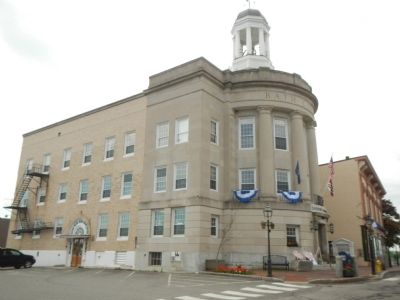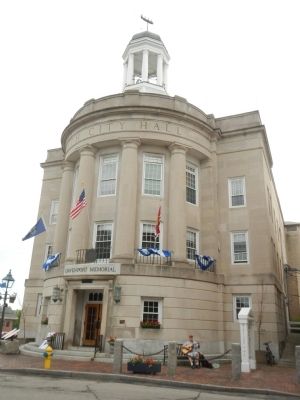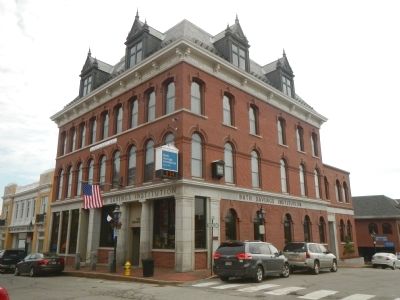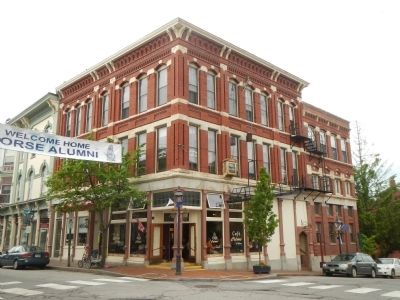Bath in Sagadahoc County, Maine — The American Northeast (New England)
City of Bath
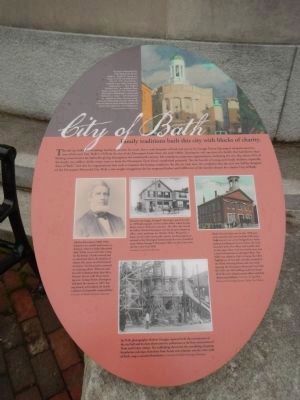
Photographed By Barry Swackhamer, June 6, 2014
1. Family traditions built this city with blocks of charity Marker
Captions: (top) Davenport Memorial City Hall, designed by Boston architect Charles G. Loring, was begun in 1928 and dedicated on May 29, 1929. Described by a dedication-day article in the Bath Independence as “New England Colonial style,” the building’s from facade resembled the 1832 Merchant’s Exchange in Philadelphia, which itself looked to an ancient Greek monument for inspiration. Many American architects were still pulling concepts and details from the past to create enduring symbols of power and stability for civic architecture.; (bottom group of photographs, clockwise from the upper left) Charles Davenport (1809-1901) learned to be careful with money at thirteen when his father Benjamin died. While concerned with caring for his family, Charles seemed just as concerned about the families of others, His career revolved around insurance, but his passion centered on assisting others. When he and his wife Catharine died, they left a fortune, but not a will. Their surviving son, George Patten Davenport, inherited the money in 1907, having already internalized the family tradition of charitable responsibility.; Seated in the buggy, George P. Davenport posed for his ca. 1896 photograph, in front of his office, where he handled a variety of business interests. The office also served his father Charles Davenport, but the property be can as office, store, and home for Charles’ father, Benjamin, a hatter, in the early nineteenth century. So the property remained in the Davenport family hands for over a hundred years, before George P. Davenport left it to the City as the site for a new City Hall.; Bath’s first city hall, seen in this 1908 postcard, started as the town hall in 1838, since Bath was not yet a city. Designed as a multi-purpose building on Centre Street, the brick structure held civic offices and a public hall on the upper floor, with two retail stores and a small schoolroom on the lower floor. The belfry was added in 1861 to house the 1802 Paul Revere & Son bell, initially installed in the North Meeting House and now residing atop the Davenport Memorial City Hall. By 1920, the old building could not house all the city’s departmental offices and had structural problems.; In 1928, photographer Herbert Douglas captured both the construction of the city hall and its close observation by pedestrians at the busy intersection of Front and Centre Streets. The scaffolding almost hide the assembling of granite foundation and steps, limestone front facade and columns, and other walls of brick, atop a concrete foundation.
Family traditions built this city with blocks of charity.
The old city hall’s shortcomings had been obvious for years, but it took bequest of land and money by George Patten Davenport to spark construction of the new City Hall in 1928 on the site of the Davenport home from the early 1800s. Davenport, sole survivor of a family that had shown their livelong commitment to charitable giving throughout the nineteenth century, left monies to numerous organizations, including the city. But about 94% of the nearly two-million dollar estate went to form the Davenport Trust Fund, established primarily “for the benefit of young and needy children, especially those of Bath,” and also for organizations that seek to improve the human condition. By this act and, also, the condition that the new city hall be designated the Davenport Memorial City Hall, a son sought recognition for his respected father and fulfillment of the family’s dream for a better City of Bath.
Family traditions built this city with brick and commercial activity.
Oliver Moses, his brother William, and their descendants made an indelible mark on the character of Bath’s downtown. Business blocks on Front Street,raised over a 70-year period, have been associated with the Moses family. These buildings illustrated their time of construction: the simplicity of Greek Revival from the 1830s and 1840s; the embellished convinces and arched windows of the Italianate from the 1860s; and the varied ornaments from the classical revivals of the late nineteenth century.
Those earliest structures housed the family’s tin and stove shop, the work the Moses foundry, a business bought by Thomas W. Hyde, which evolved into Bath Iron Works. The Italianate storefront housed a variety of businesses in structure designed by a Bath boy, Francis Fassett, who became the most important Maine architects during the nineteenth century’s third quarter, The large structures, which bookended Front Street at Centre and Summer Streets, replaced buildings destroyed by fire. John Calvin Stevens, the leading architect in Maine during the late nineteenth century, created these later buildings.
Erected by City of Bath.
Topics. This historical marker is listed in these topic lists: Arts, Letters, Music • Industry & Commerce. A significant historical year for this entry is 1928.
Location. 43° 54.769′ N, 69° 48.843′ W. Marker is in Bath, Maine, in Sagadahoc County. Marker is at the intersection of Front Street and Centre Street, on the right when traveling north on Front Street. Touch for map
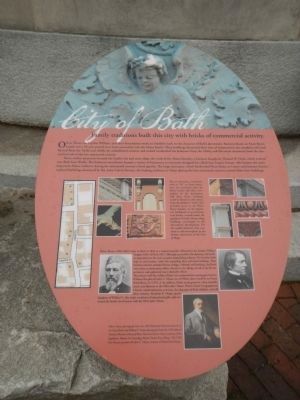
Photographed By Barry Swackhamer, June 6, 2014
2. Family traditions built this city with brick and commercial activity Marker
Captions: (top to bottom) The ten structures, noted here with a “M” on Front Street, were all associated with the Moses family and their stewardship of the downtown. Still other Moses buildings could be found on side streets. From the brothers’ “Arch” that provided access to the Water Street foundry to the decorative brickwork of several business blocks, created under the guidance of Galen Moses, these buildings contributed to the downtown’s development. For the careful observer, they continue to add atmosphere to the historic downtown of the City of Ships.; Oliver Moses (1803-1882) came to Bath in 1826 as a trained tinsmith, followed by his brother William Vaughn (1801-1878) in 1827. Although successful at that business, the brothers expanded into the more complex shipbuilding industry. The brothers built ships in mid-century, while also expanding their real-estate holding. And both were active in community affairs, elected to city offices, served in the fire department, and undertook many charitable efforts. The concern with the welfare of their city continued into coming generations. Without the gifts of Galen C. Moses, son of Oliver, their would be no Patten Free- Library, no Y.M.C.A. In addition, Galen made generous, often unpublicized, contributions to the Old Ladies’ Home, Winter Street Congregational Church, varied missionary activities, the education of Bath children, and still other charities. Elizabeth R. Moses, granddaughter of William V., also made a tradition of educational gifts, and continued the family involvement the Old Ladies’ Home.; Oliver Moses photograph fro the 1899 Illustrated Historical Souvenir of the City of Bath, and William V. Mose photograph from the 1936 Edward Clarence Plummer History of Bath by Henry Owen, courtesy of the Sagadahoe History & Genealogy Room, Patten Free Library. The 1928 Von Hausen portrait of Galen C. Moses, courtesy of the Patten Free Library.
Other nearby markers. At least 8 other markers are within 2 miles of this marker, measured as the crow flies. Bath Street Clock (a few steps from this marker); a different marker also named City of Bath (within shouting distance of this marker); Constable William Lawrence (within shouting distance of this marker); All Gave Some, Some Gave All - Vietnam War (about 500 feet away, measured in a direct line); Bath Civil War Memorial (approx. 0.3 miles away); Deckhouse from steamer Winapie ca.1909 (approx. 1.2 miles away); Launch day! (approx. 1.2 miles away); Shipyard Owner's Home (approx. 1.2 miles away). Touch for a list and map of all markers in Bath.
Also see . . . Bath's Historic Downtown - History Overview. The downtown of Bath evolved as a function of many local, national and international factors. Foremost among them is the city’s location on the west side of a navigable, straight, 5-mile stretch of the Kennebec River, a site that has proven to be ideal for shipbuilding for more than 200 years. (Submitted on September 13, 2014, by Barry Swackhamer of Brentwood, California.)
Credits. This page was last revised on June 16, 2016. It was originally submitted on September 13, 2014, by Barry Swackhamer of Brentwood, California. This page has been viewed 486 times since then and 22 times this year. Photos: 1, 2, 3, 4, 5, 6. submitted on September 13, 2014, by Barry Swackhamer of Brentwood, California. • Bill Pfingsten was the editor who published this page.
